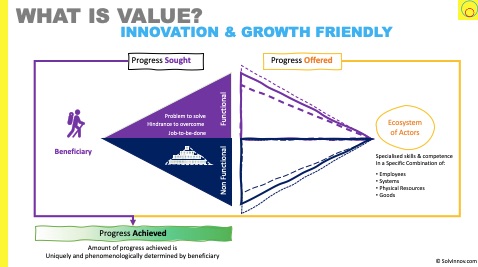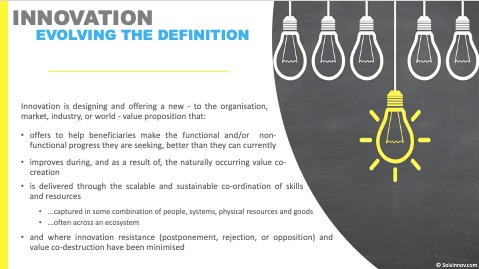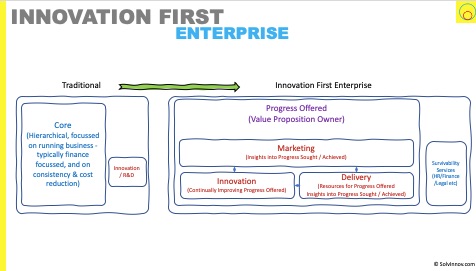94% of executives have an innovation problem...
“94% of executives are unsatisfied with innovation performance”. Yet “84% see innovation as important to growth”! Whilst “54% of companies struggle to bridge the gap between innovation and business”. Worse; “very few executives know what the problem is and how to fix it”! So we end up with little more than innovation theater.
This is the innovation problem.
It's great that we nearly all recognise innovation as important to growth. At the fundamental level we all see that we need to keep and get the next customer. And to do that we need to keep our offerings fresh. But sadly our efforts usually fail to achieve tangible outputs that move bottom lines. Leading to the 94% of execs being unsatisfied with innovation performance.
Our "solutions" come from following today's trends - innovation competitions, open innovation, latest tool from innovation consultants. We drive a lot of innovation activities. These make us - innovation officers, sponsoring executives, and those involved - initially feel great. But, be honet with youself. How much has resulted in tangible output. Unfortunately, we end up performing a lot of innovation theatre.
We don’t appreciate how inefficient “ideas-first” approaches are. We get misalignment with strategy, poor quality, miscommunications, ideas we can't execute and so on. Yet we pat ourselves on the back, saying this was fun, convincing ourselves that the intangible team and spirit building we've done has great future benefits. And we can tell shareholders that we are innovative. And of course, innovation is hard isn't it - we'll get those tangible outputs eventually!
That "very few executives know what the problem is and how to fix it" is not surprising if we take today's context. Innovation is seen as something separate. Being done as an add-on or a bolt-on. Our innovation theories, as well as practices, are developed from observing manufacturing industries decades, if not centuries ago. Yet our economies are service economies.
And we have forgotten the basics, that have been known for decades. That “the firm has two, and only two activities: marketing and innovation” (Drucker, 1954). And that “people don’t want to buy a 1/4 inch drill; they want a 1/4 inch hole” (Levett, 1975).
No wonder McKinsey found 94% of executives are unhappy with innovation performance.
But, I believe we can fix this...
...Let's fix that!
This is the work in progress on this site. I believe we can fix the innovation problem. And to do so, we just need to think differently about:
- Value
- Innovation
- Enterprise operation
This is the innovation solution.
And it is based in using a service-dominant logic lens to see the world. Along the way we find a natural home for modern theories such as Christensen's Jobs-to-be-done, Kim & Mauborgne's Blue Ocean, agile approaches and more. And, we minimise marketing myopia. Systematically search for growth. And address the circular economy as an obvious part of value proposition.

Check out The Progress Economy - my operational lens on the way the world works - it enables the systematic hunting of innovation and growth. It is built from the ideas explored on this site.
1. Re-Think Value
We start with a better (more correct) view of value.
One that is based around progress - sought, proposed and achieved. Not amount of cash we can get in a sale (aka value-in-exchange)).
Where we see value as being co-created during use. That it can also be co-destructed. And is always determined by the beneficiary; each and every time they engage.
Moving away from our common value-in-exchange view naturally opens up a relational approach reaching beyond a sale; unlocking additional value opportunities, including the circular economy.
All this comes from observing the world is service-first. It should be seen through a service-dominant lens. Rather than the traditional goods-dominant lens with its goods vs service view and where manufacturers determine value.
Our new world is one where everything is a service - goods are a way of transporting service in time and space. Leading to a service-service continuum. And looping back to the idea that value relates to progress sought, proposed and achieved.
2. Re-Define Innovation
Building on that view of value we can define a new, actionable, definition of innovation.
In short offering something that helps beneficiaries make functional and non-functional progress they are seeking in a better way than they currently can.
We are still standing on the shoulders of innovation classics. But make our definition based on improving value (progress proposed and achieved). As well as addressing aspects we often miss, such as innovation resistance and ecosystems.
Together with our service-first view we can now build tools to:
- systematically hunt innovations by
- understanding/identifying progress sought and proposing (new) ways to achieve that
- altering the service mix
- exploring the service model
- bridge the language and concept gaps between innovators and fund holders
- provide context to modern innovation (growth) theories such as Blue Ocean Strategy and Jobs-to-be-done
3. Re-Tool Enterprise
Innovation requires change.
So we first need to understand what the execution complexity of an innovation is on our enterprise. Then we can look to engineer down that complexity and/or improve our enterprise capabilities to execute.
And there are many blockers to change (innovation) in our enterprises. Not least, we tend to treat innovation as a bolt-on activity, decoupling it from the enterprise's typical reality. Yet to paraphrase Drucker from many decades ago:
a firm only has only two functions: innovation and marketing.
We can redefine what is an enterprise. And then propose how to remove those blockers to change which inhibit our ability to execute innovations
The ultimate aim is an innovation-first enterprise (which you might call business agility) that embodies Drucker's view up front. With other functions being seen as survivability supporting functions. Somewhat opposite to most of today's enterprise reality.
Content Journeys
Beyond reading my articles individually, I've collected some of them together as journeys. Each journey addresses a specific topic as you'll see below.

Reviewing some of the essentials to know about innovation

Let's look at what value really means and how it is co-created

Busting some of the myths about service, and defining what service really means.

Take a tour through the underlying logic that informs my thoughts.

Here are the various tools that can help drive your innovation.
Who am I?
I've been a Chief Innovation Officer on the front line and experienced first hand the challenges of creating and setting up an innovation initiative in a global account. I have suffered the highs of getting 20+ innovations into an innovation pipeline; only to find getting traction and tangible results a challenge.
So I took some time out, went to the fantastic Business School at Imperial College London to delve into an MBA. My thinking was to get a broader view of business and uncover some clues to this innovation problem. And there, I found some hints in the form of service-dominant logic.
So, on this site I'm following that rabbit warren all the way down to build up how we can fix the innovation problem.
Latest Articles
"Continuous improvement is better than delayed perfection"














